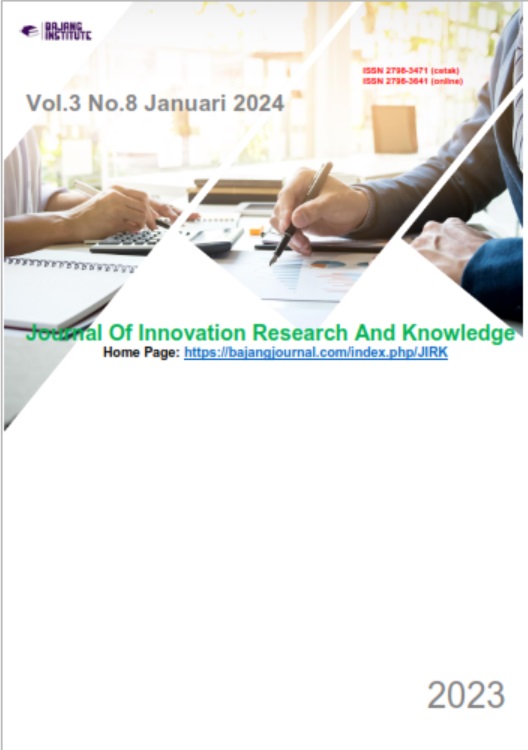EVALUATION OF NUTRITIONAL EARTH WORMS (LUMBRICUS RUBELLUS) AS A SUBSTITUTE FOR FISH MEAL IN BASAL FEEDING FOR POULTRY
DOI:
https://doi.org/10.53625/jirk.v3i8.7300Keywords:
Earthworms, Gross Energy, Crude Fat, Crude ProteinAbstract
The aim of this research is to improve the nutritional quality (crude protein, gross energy and crude fat) in basal feed for poultry by providing earthworm meal as a substitute for fish meal. The hypothesis of this research is that the use of earthworm meal as a substitute for fish meal can increase the nutritional value (crude protein, gross energy and crude fat) in basal feed for cnpoultry. The materials used in the research were earthworm flour, fine corn bran, rice bran, DDGS (Distillers Dried Grains with Solubles), soybean meal, fish meal, coconut oil, premix and salt. Materials for chemical feed nutrition tests are H2SO4, NaOH, Acetone, Boric acid HCl and methyl red indicator. The research method used in the research was a non-factorial Completely Randomized Design (CRD) with 5 treatments and 4 replications. The treatments given were as follows: P0 (Basal feed for poultry (using 10% fish meal without earthworm meal) / Control); P1 (Basal feed for poultry (using 7.5% fish meal and 2.5% earthworm meal)); P2 (Basal feed for poultry (using 5% fish meal and 5% earthworm meal)); P3 (Basal feed for poultry (using 2.5% fish meal and 7.5% earthworm meal); P4 (Basal feed for poultry (using 10% earthworm meal without fish meal)). The parameters observed include analysis of the nutritional content of crude protein, gross energy and crude fat. Proximate testing is carried out in the laboratory. The conclusion of this research is that giving earthworm meal as a substitute for fish meal in basal feed for poultry up to a level of 10% can increase crude protein, gross energy and crude fat.
References
Almatsier, S. (2003) Prinsip Dasar Ilmu Gizi.Jakarta: Gramedia Pustaka Utama.
Andriani, R., Gubali, S. I., & Sayuti, M. (2022). Kandungan Protein Kasar, Serat Kasar Dan Energi Formulasi Ransum Burung Puyuh Petelur Yang Ditambah Tepung Daun Kelor (Moringa oleifera Lam.). Gorontalo Journal of Equatorial Animals, 1(2).
Aziz, A. 2015. Budidaya Cacing Tanah Unggul ala Adam. Jakarta. AgroMedia Pustaka.
Febrita, E., Darmadi, & Siswanto, E. 2015. Pertumbuhan Cacing Tanah (Lumbricus rubellus) dengan Pemberian Pakan Buatan untuk Mendukung Proses Pembelajaran pada Konsep Pertumbuhan dan Perkembangan Invertebrata. Jurnal Biogenesis Vol. 11(2): 169-176. ISSN: 1829-5460.
Ibrahim, S. (2006). Pengaruh pemberian tepung ikan Lemuru terhadap persentase karkas broiler. Jurnal Agripet, 6(2), 39-44.
Nazilah, R. (2004). Kajian Interaksi Sifat Fisik dan Kimia Bahan Pakan Serta Kecernaan Lemak pada Kambing (Doctoral dissertation, IPB (Bogor Agricultural University)).
Siregar, D. J. S., Warisman, W., Setyaningrum, S., dan Amrul, H. M. Z. “Pemanfaatan Larva Lalat Black Solder Fly (Hermetia illucens) dengan Berbagai Media Berbeda sebagai Pakan Puyuh untuk Meningkatkan Pendapatan Masyarakat”. JPKMI (Jurnal Pengabdian Kepada Masyarakat Indonesia). Vol. 3, No. 1, (Februari 2022): 88-95.
Siregar, D. J. S. (2018). Pemanfaatan tepung bawang putih (allium sativum l) sebagai feedadditif pada pakan terhadap pertumbuhan ayam broiler. Jurnal Ilmiah Abdi Ilmu, 10(2), 1823-1828.
Standar Nasional Indonesia. 2008. Kumpulan SNI Bidang Pakan. Direktorat Budidaya Ternak Non Ruminansia, Direktorat Jendral Peternakan, Departemen Pertanian, Jakarta.
Sumadi, I. K. (2017). Prinsip-Prinsip Ilmu Gizi Ternak Babi. Bali: Fakultas Peternakan Universitas Udayana.
Wahyu, J. 2004. Ilmu Nutrisi Unggas. Cetakan ke-5. Gadjah Mada UniversityPress.Yogyakarta.













